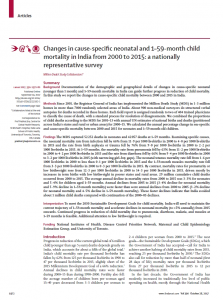
Background
Documentation of the demographic and geographical details of changes in cause-specific neonatal (younger than 1 month) and 1–59-month mortality in India can guide further progress in reduction of child mortality. In this study we report the changes in cause-specific child mortality between 2000 and 2015 in India.
Methods
Since 2001, the Registrar General of India has implemented the Million Death Study (MDS) in 1·3 million homes in more than 7000 randomly selected areas of India. About 900 non-medical surveyors do structured verbal autopsies for deaths recorded in these homes. Each field report is assigned randomly to two of 404 trained physicians to classify the cause of death, with a standard process for resolution of disagreements. We combined the proportions of child deaths according to the MDS for 2001–13 with annual UN estimates of national births and deaths (partitioned across India’s states and rural or urban areas) for 2000–15. We calculated the annual percentage change in sex-specific and cause-specific mortality between 2000 and 2015 for neonates and 1–59-month-old children.
Findings
The MDS captured 52 252 deaths in neonates and 42 057 deaths at 1–59 months. Examining specific causes, the neonatal mortality rate from infection fell by 66% from 11·9 per 1000 livebirths in 2000 to 4·0 per 1000 livebirths in 2015 and the rate from birth asphyxia or trauma fell by 76% from 9·0 per 1000 livebirths in 2000 to 2·2 per 1000 livebirths in 2015. At 1–59 months, the mortality rate from pneumonia fell by 63% from 11·2 per 1000 livebirths in 2000 to 4·2 per 1000 livebirths in 2015 and the rate from diarrhoea fell by 66% from 9·4 per 1000 livebirths in 2000 to 3·2 per 1000 livebirths in 2015 (with narrowing girl–boy gaps). The neonatal tetanus mortality rate fell from 1·6 per 1000 livebirths in 2000 to less than 0·1 per 1000 livebirths in 2015 and the 1–59-month measles mortality rate fell from 3·3 per 1000 livebirths in 2000 to 0·3 per 1000 livebirths in 2015. By contrast, mortality rates for prematurity or low birthweight rose from 12·3 per 1000 livebirths in 2000 to 14·3 per 1000 livebirths in 2015, driven mostly by increases in term births with low birthweight in poorer states and rural areas. 29 million cumulative child deaths occurred from 2000 to 2015. The average annual decline in mortality rates from 2000 to 2015 was 3·3% for neonates and 5·4% for children aged 1–59 months. Annual declines from 2005 to 2015 (3·4% decline for neonatal mortality and 5·9% decline in 1–59-month mortality) were faster than were annual declines from 2000 to 2005 (3·2% decline for neonatal mortality and 4·5% decline in 1–59-month mortality). These faster declines indicate that India avoided about 1 million child deaths compared with continuation of the 2000–05 declines.